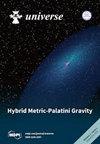欧洲上空行星际日冕物质抛射(ICME)和同向相互作用区(CIR)驱动的地磁暴期间的电离层测量比较
IF 2.5
4区 物理与天体物理
Q2 ASTRONOMY & ASTROPHYSICS
引用次数: 0
摘要
本研究详细比较了行星际日冕物质抛射(ICME)和冠状相互作用区(CIR)驱动的地磁暴事件期间欧洲的三种电离层探测仪数据。所选事件为:2015 年 3 月 16 日至 20 日为 ICME 驱动的风暴,2013 年 5 月 30 日至 6 月 4 日为 CIR 驱动的风暴。本研究调查了欧洲三个电离层探测站的电离层数据,即 Pruhonice (PQ)、Sopron (SO) 和 Rome (RO)。利用电离层 foF2 和 h'F2 参数、计算得出的 deltafoF2 和 deltahF2 值、总电子含量比(rTEC)以及热层、电离层、中间层、能量学和动力学(TIMED)卫星全球紫外线成像仪(GUVI)热大气层[O]/[N2]测量数据分析了电离层 F2 层对这些地磁事件的响应。还比较了风暴时和静止日的平均值,得出的结论是,所有台站的静止日曲线相似,而风暴时的曲线在风暴发展过程中显示出纬度依赖性。电子密度比较的结果是,在这两个事件期间,可以得出结论认为,以突发暴风雪为特征的突发暴风雪在主要阶段诱发了欧洲台站出现的巡回大气扰动(TAD),而在 CIR 驱动的电离层暴风雪中却没有出现这种情况,所有台站都出现了更强烈和更持久的负面影响,这可能是由于季节和 O/N2 比值耗尽造成的。本文章由计算机程序翻译,如有差异,请以英文原文为准。
Ionosonde Measurement Comparison during an Interplanetary Coronal Mass Ejection (ICME)- and a Corotating Interaction Region (CIR)-Driven Geomagnetic Storm over Europe
A comparison of three types of ionosonde data from Europe during an interplanetary coronal mass ejection (ICME)- and a corotating interaction region (CIR)-driven geomagnetic storm event is detailed in this study. The selected events are 16–20 March 2015 for the ICME-driven storm and 30 May to 4 June 2013 for the CIR-driven one. Ionospheric data from three European ionosonde stations, namely Pruhonice (PQ), Sopron (SO) and Rome (RO), are investigated. The ionospheric F2-layer responses to these geomagnetic events are analyzed with the ionospheric foF2 and h’F2 parameters, the calculated deltafoF2 and deltahF2 values, the ratio of total electron content (rTEC) and Thermosphere, Ionosphere, Mesosphere, Energetics and Dynamics (TIMED) satellite Global Ultraviolet Imager (GUVI) thermospheric [O]/[N2] measurement data. The storm-time and the quiet-day mean values are also compared, and it can be concluded that the quiet-day curves are similar at all the stations while the storm-time ones show the latitudinal dependence during the development of the storm. As a result of the electron density comparison, during the two events, it can be concluded that the sudden storm commencement (SSC) that characterized the ICME induced a traveling atmospheric disturbance (TAD) seen in the European stations in the main phase, while this is not seen in the CIR-driven ionospheric storm, which shows a stronger and more prolonged negative effect in all the stations, probably due to the season and the depleted O/N2 ratio.
求助全文
通过发布文献求助,成功后即可免费获取论文全文。
去求助
来源期刊

Universe
Physics and Astronomy-General Physics and Astronomy
CiteScore
4.30
自引率
17.20%
发文量
562
审稿时长
24.38 days
期刊介绍:
Universe (ISSN 2218-1997) is an international peer-reviewed open access journal focused on fundamental principles in physics. It publishes reviews, research papers, communications, conference reports and short notes. Our aim is to encourage scientists to publish their research results in as much detail as possible. There is no restriction on the length of the papers.
 求助内容:
求助内容: 应助结果提醒方式:
应助结果提醒方式:


